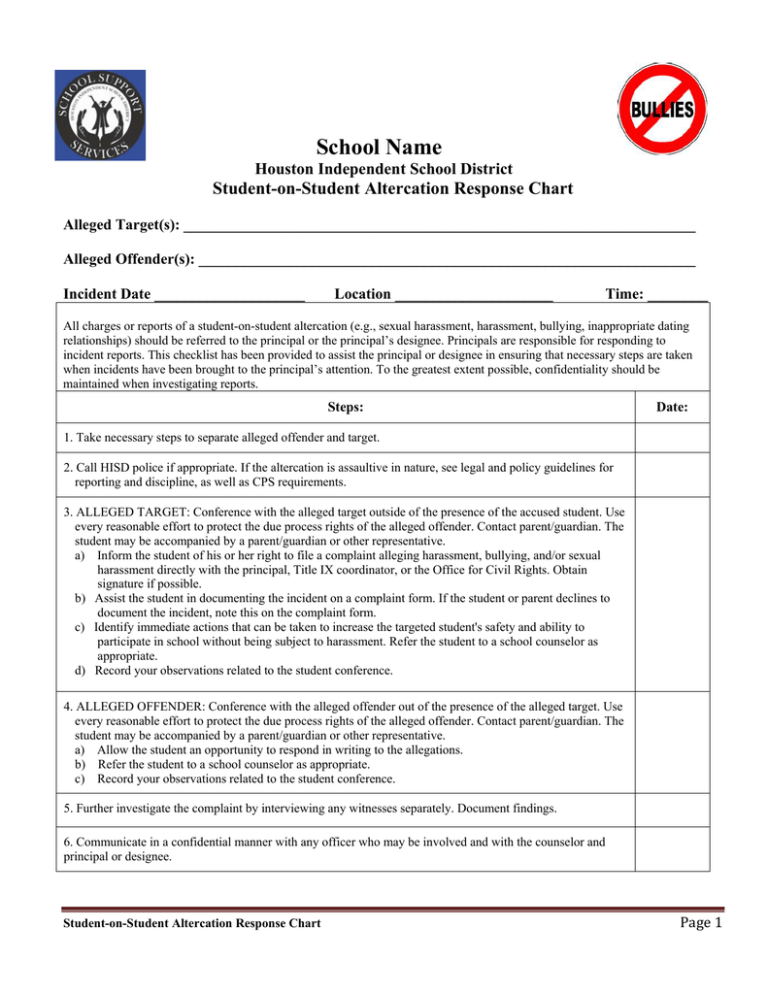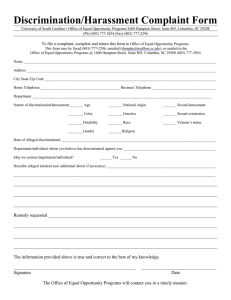
School Name
Houston Independent School District
Student-on-Student Altercation Response Chart
Alleged Target(s): ____________________________________________________________________
Alleged Offender(s): __________________________________________________________________
Incident Date ____________________
Location _____________________
Time: ________
All charges or reports of a student-on-student altercation (e.g., sexual harassment, harassment, bullying, inappropriate dating
relationships) should be referred to the principal or the principal’s designee. Principals are responsible for responding to
incident reports. This checklist has been provided to assist the principal or designee in ensuring that necessary steps are taken
when incidents have been brought to the principal’s attention. To the greatest extent possible, confidentiality should be
maintained when investigating reports.
Steps:
Date:
1. Take necessary steps to separate alleged offender and target.
2. Call HISD police if appropriate. If the altercation is assaultive in nature, see legal and policy guidelines for
reporting and discipline, as well as CPS requirements.
3. ALLEGED TARGET: Conference with the alleged target outside of the presence of the accused student. Use
every reasonable effort to protect the due process rights of the alleged offender. Contact parent/guardian. The
student may be accompanied by a parent/guardian or other representative.
a) Inform the student of his or her right to file a complaint alleging harassment, bullying, and/or sexual
harassment directly with the principal, Title IX coordinator, or the Office for Civil Rights. Obtain
signature if possible.
b) Assist the student in documenting the incident on a complaint form. If the student or parent declines to
document the incident, note this on the complaint form.
c) Identify immediate actions that can be taken to increase the targeted student's safety and ability to
participate in school without being subject to harassment. Refer the student to a school counselor as
appropriate.
d) Record your observations related to the student conference.
4. ALLEGED OFFENDER: Conference with the alleged offender out of the presence of the alleged target. Use
every reasonable effort to protect the due process rights of the alleged offender. Contact parent/guardian. The
student may be accompanied by a parent/guardian or other representative.
a) Allow the student an opportunity to respond in writing to the allegations.
b) Refer the student to a school counselor as appropriate.
c) Record your observations related to the student conference.
5. Further investigate the complaint by interviewing any witnesses separately. Document findings.
6. Communicate in a confidential manner with any officer who may be involved and with the counselor and
principal or designee.
Student-on-Student Altercation Response Chart Page 1 7.
Make determinations regarding alleged conduct, ordinarily within 5 (five) days. If extenuating circumstances delay the
investigation, inform the alleged target or parent. Record determination and actions, as follows (check box):
Findings indicate that a student-on-student altercation occurred.
a) VICTIM: Conference with the alleged victim and parent/guardian. Possible interventions:
Identify actions to increase the targeted student's safety and ability to participate in school
without fear or intimidation.
Inform the student and parent of support services.
Ensure the alleged victim has access to support when needed (e.g., administrator or counselor
gives his/her business card to the student to carry and writes on the back: Please allow NAME
to see me when requested.)
Inform the student of his or her right to request a “Stay Away Agreement.”
Encourage the target to report further incidences.
Parent has right to pursue transfer as a victim of bullying. Share form and process as
appropriate. Requires verification of harassment/bullying from administration.
Bullying Task Force referral if appropriate.
Document conference and action plans.
b) OFFENDER: Conference with the alleged offender and parent. Possible interventions:
Emphasize expectations for positive behavior.
Identify and implement disciplinary consequences and other actions that will be taken to
prevent further incidences.
Inform the student and parent of support services.
Ensure the alleged offender has access to support when needed (e.g., administrator or
counselor gives his/her business card to the student to carry and writes on the back: Please
allow NAME to see me when requested.)
Address the seriousness of retaliation.
If harassment was severe or repeated, a “Stay Away Agreement” may be issued.
Depending on the nature of the offense, disciplinary action may be warranted or mandated.
Increase supervision of the offending student as appropriate.
Behavior contract.
CSST Team referral if appropriate.
c)
REMINDER: If there is a finding that the altercation involved physical or sexual assault or threats, notify the
police immediately and follow legal and policy guidelines for reporting and discipline, as well as CPS
requirements.
Unable to determine that inappropriate behavior occurred, but there has been a determination that the situation justifies
the communication of warnings, recommendations, and/or information regarding support services.
There are no findings of inappropriate behavior.
8. After determination made:
Give notice of the outcome to the parties – follow FERPA guidelines.
Advise the parents and students that they may appeal the decision of the principal or designee
regarding the outcome of the. Inform the student or parent that he or she has 10 (ten) days to appeal.
9. If findings indicate that inappropriate behavior has occurred:
Monitor the safety of the target
Encourage the target to immediately communicate any safety concerns that may arise to an
administrator or counselor or officer.
Document subsequent follow-up actions and complaints in the space provided on the complaint form.
10. Store complaint forms in a separate, confidential file.
Student-on-Student Altercation Response Chart Page 2


